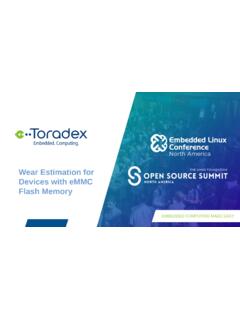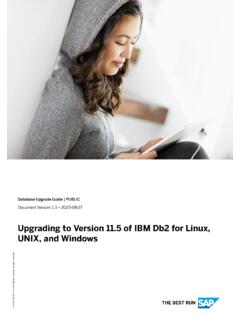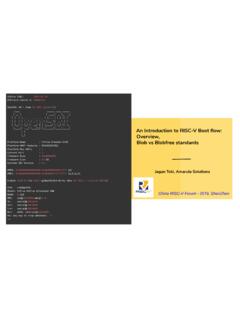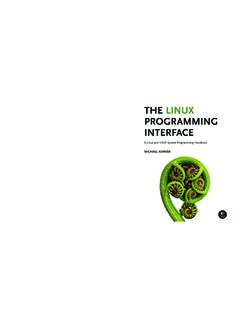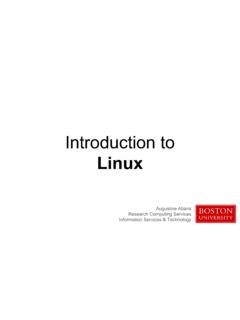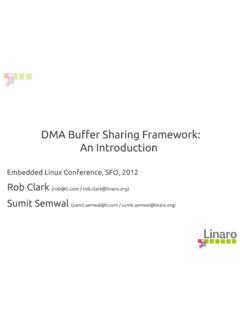Transcription of An Introduction to the Video4Linux Framework
1 1 2014 Cisco and/or its affiliates. All rights Introduction to the Video4 Linux FrameworkHans VerkuilCisco Systems NorwayCisco Confidential2 2014 Cisco and/or its affiliates. All rights & Architecture 2014 Cisco and/or its affiliates. All rights Features Video capture/output and tuning (/dev/videoX, streaming and control) Video capture and output overlay (/dev/videoX, control) Memory-to-Memory (aka codec) devices (/dev/videoX, streaming and control) Raw and Sliced VBI capture and output (/dev/vbiX, streaming and control) Radio tuning and modulating (/dev/radioX, control, ALSA for streaming) RDS receiver/transmitter (/dev/radioX, streaming and control) Software Defined Radio (/dev/swradioX, streaming and control) Low-level sub-device control (/dev/v4l-subdevX, control) Device topology discovery/control (/dev/mediaX, control) 2014 Cisco and/or its affiliates. All rights Driver architecture The bridge driver controls the platform/USB/PCI/.
2 Hardware that is responsible for the DMA transfers. Based on the board configuration (USB ID, PCI ID, kernel config, device tree, module options) the necessary sub-device drivers are loaded. The bridge driver finally registers the device nodes it needs. Consequences for the Device Tree model: sub-devices need to defer initialization until the bridge driver has been loaded. The bridge driver needs to postpone initializing sub-devices until all required sub-devices have been loaded (v4l2-async).Cisco Confidential5 2014 Cisco and/or its affiliates. All rights PCI Skeleton DriverBasics 2014 Cisco and/or its affiliates. All rights Features of the Skeleton Driver It has two inputs: input 0 is an S-Video input (SDTV) and input 1 is an HDMI input (HDTV) up to MHz pixelclock. It supports the 4:2:2 YUYV image format. It supports brightness, contrast, saturation and hue controls. 2014 Cisco and/or its affiliates.
3 All rights struct v4l2_device (1) Top level struct. Misnomer: a better name would have been v4l2_root. v4l2_device_(un)register should have been called v4l2_root_init/exit. Maintains list of sub-devices. Has notify() callback for sub-devices. Has release() callback called when the last device reference goes away. 2014 Cisco and/or its affiliates. All rights struct v4l2_device (2)#include < >#include < >MODULE_DESCRIPTION("V4L2 PCI Skeleton Driver");MODULE_AUTHOR("Hans Verkuil");MODULE_LICENSE("GPL v2");MODULE_DEVICE_TABLE(pci, skeleton_pci_tbl);struct skeleton { struct pci_dev *pdev; struct v4l2_device v4l2_dev;};static const struct pci_device_id skeleton_pci_tbl[] = { { PCI_DEVICE(PCI_VENDOR_ID_FOO, PCI_DEVICE_ID_BAR) }, { 0, }};<skeleton_probe> <skeleton_remove>static struct pci_driver skeleton_driver = { .name = KBUILD_MODNAME, .probe = skeleton_probe.}
4 Remove = skeleton_remove, .id_table = skeleton_pci_tbl,};module_pci_driver(ske leton_driver); 2014 Cisco and/or its affiliates. All rights struct v4l2_device (3)static int skeleton_probe(struct pci_dev *pdev, const struct pci_device_id *ent){ struct skeleton *skel; int ret; pci_enable_device(pdev); pci_set_dma_mask(pdev, DMA_BIT_MASK(32)); skel = devm_kzalloc(&pdev->dev, sizeof(struct skeleton), GFP_KERNEL); if (!skel) return -ENOMEM; skel->pdev = pdev; ret = v4l2_device_register(&pdev->dev, &skel->v4l2_dev); if (ret) goto disable_pci; dev_info(&pdev->dev, "V4L2 PCI Skeleton Driver loaded\n"); return 0;disable_pci: pci_disable_device(pdev); return ret;}static void skeleton_remove(struct pci_dev *pdev){ struct v4l2_device *v4l2_dev = pci_get_drvdata(pdev); struct skeleton *skel = container_of(v4l2_dev, struct skeleton, v4l2_dev); v4l2_device_unregister(&skel->v4l2_dev); pci_disable_device(skel->pdev);} 2014 Cisco and/or its affiliates.
5 All rights struct video_device (1) Represents a video/radio/vbi/v4l2_subdev device node in /dev. Pointer to v4l2_file_operations for the file operations. Pointer to v4l2_ioctl_ops for ioctl operations. Often represents a DMA engine as well: pointer to vb2_queue. Core locking support: lock mutex, : If lock == NULL, then the driver does all locking. If lock != NULL but == NULL, then all ioctls are serialized through that lock, including the streaming ioctls. If is also != NULL then that lock is used for all the streaming ioctls: useful if other ioctls can hold the core lock for a long time (typical for USB drivers). The driver always does all the locking for non-ioctl file operations. My personal recommendation: use core locking. 2014 Cisco and/or its affiliates. All rights struct video_device (2)struct skeleton { struct pci_dev *pdev; struct v4l2_device v4l2_dev; struct video_device vdev; struct mutex lock;};static int skeleton_probe(struct pci_dev *pdev, const struct pci_device_id *ent){.}
6 Mutex_init(&skel->lock); vdev = &skel->vdev; strlcpy(vdev->name, KBUILD_MODNAME, sizeof(vdev->name)); vdev->release = video_device_release_empty; vdev->fops = &skel_fops, vdev->ioctl_ops = &skel_ioctl_ops, vdev->lock = &skel->lock; vdev->v4l2_dev = &skel->v4l2_dev; /* Supported SDTV standards, if any */ vdev->tvnorms = V4L2_STD_ALL; set_bit(V4L2_FL_USE_FH_PRIO, &vdev->flags); video_set_drvdata(vdev, skel); ret = video_register_device(vdev, VFL_TYPE_GRABBER, -1); if (ret) goto v4l2_dev_unreg; dev_info(&pdev->dev, "V4L2 PCI Skeleton Driver loaded\n"); return 0; ..} 2014 Cisco and/or its affiliates. All rights struct video_device (3)static int skeleton_querycap(struct file *file, void *priv, struct v4l2_capability *cap){ struct skeleton *skel = video_drvdata(file); strlcpy(cap->driver, KBUILD_MODNAME, sizeof(cap->driver)); strlcpy(cap->card, "V4L2 PCI Skeleton", sizeof(cap->card)); snprintf(cap->bus_info, sizeof(cap->bus_info), "PCI:%s", pci_name(skel->pdev)); cap->device_caps = V4L2_CAP_VIDEO_CAPTURE | V4L2_CAP_READWRITE | V4L2_CAP_STREAMING; cap->capabilities = cap->device_caps | V4L2_CAP_DEVICE_CAPS; return 0;}static const struct v4l2_ioctl_ops skel_ioctl_ops = {.
7 Vidioc_querycap = skeleton_querycap,};static const struct v4l2_file_operations skel_fops = { .owner = THIS_MODULE, .open = v4l2_fh_open, .release = v4l2_fh_release, .unlocked_ioctl = video_ioctl2,}; 2014 Cisco and/or its affiliates. All rights Input ioctls (1)static int skeleton_enum_input(struct file *file, void *priv, struct v4l2_input *i){ if (i->index > 1) return -EINVAL; i->type = V4L2_INPUT_TYPE_CAMERA; if (i->index == 0) { i->std = V4L2_STD_ALL; strlcpy(i->name, "S-Video", sizeof(i->name)); i->capabilities = V4L2_IN_CAP_STD; } else { i->std = 0; strlcpy(i->name, "HDMI", sizeof(i->name)); i->capabilities = V4L2_IN_CAP_DV_TIMINGS; } return 0;}static const struct v4l2_ioctl_ops skel_ioctl_ops = {.
8 Vidioc_enum_input = skeleton_enum_input,}; 2014 Cisco and/or its affiliates. All rights Input ioctls (2)static int skeleton_s_input(struct file *file, void *priv, unsigned int i){ struct skeleton *skel = video_drvdata(file); if (i > 1) return -EINVAL; skel->input = i; skel-> = i ? 0 : V4L2_STD_ALL; skeleton_fill_pix_format(skel, &skel->format); return 0;}static int skeleton_g_input(struct file *file, void *priv, unsigned int *i){ struct skeleton *skel = video_drvdata(file); *i = skel->input; return 0;}static const struct v4l2_ioctl_ops skel_ioctl_ops = { .vidioc_g_input = skeleton_g_input, .vidioc_s_input = skeleton_s_input,}; 2014 Cisco and/or its affiliates. All rights SDTV Standards ioctls (1)static int skeleton_s_std(struct file *file, void *priv, v4l2_std_id std){ struct skeleton *skel = video_drvdata(file); if (skel->input) return -ENODATA; if (std == skel->std) return 0; /* TODO: handle changing std */ skel->std = std; skeleton_fill_pix_format(skel, &skel->format); return 0;}static int skeleton_g_std(struct file *file, void *priv, v4l2_std_id *std){ struct skeleton *skel = video_drvdata(file); if (skel->input) return -ENODATA; *std = skel->std; return 0;}static const struct v4l2_ioctl_ops skel_ioctl_ops = {.
9 Vidioc_g_std = skeleton_g_std, .vidioc_s_std = skeleton_s_std,}; 2014 Cisco and/or its affiliates. All rights SDTV Standards ioctls (2)static int skeleton_querystd(struct file *file, void *priv, v4l2_std_id *std){ struct skeleton *skel = video_drvdata(file); if (skel->input) return -ENODATA; /* TODO: Query currently seen standard. */ return 0;}static const struct v4l2_ioctl_ops skel_ioctl_ops = { .vidioc_querystd = skeleton_querystd,}; 2014 Cisco and/or its affiliates. All rights DV Timings ioctls (1)static const struct v4l2_dv_timings_cap skel_timings_cap = { .type = V4L2_DV_BT_656_1120, /* keep this initialization for compatibility with GCC < */ .reserved = { 0 }, V4L2_INIT_BT_TIMINGS( 720, 1920, /* min/max width */ 480, 1080, /* min/max height */ 27000000, 74250000, /* min/max pixelclock*/ V4L2_DV_BT_STD_CEA861, /* Supported standards */ /* capabilities */ V4L2_DV_BT_CAP_INTERLACED | V4L2_DV_BT_CAP_PROGRESSIVE )};static int skeleton_dv_timings_cap(struct file *file, void *fh, struct v4l2_dv_timings_cap *cap){ struct skeleton *skel = video_drvdata(file); if (skel->input == 0) return -ENODATA; *cap = skel_timings_cap; return 0;}static const struct v4l2_ioctl_ops skel_ioctl_ops = {.
10 Vidioc_dv_timings_cap = skeleton_dv_timings_cap,}; 2014 Cisco and/or its affiliates. All rights DV Timings ioctls (2)static int skeleton_s_dv_timings(struct file *file, void *_fh, struct v4l2_dv_timings *timings){ struct skeleton *skel = video_drvdata(file); if (skel->input == 0) return -ENODATA; if (!v4l2_valid_dv_timings(timings, &skel_timings_cap, NULL, NULL)) return -EINVAL; if (!v4l2_find_dv_timings_cap(timings, &skel_timings_cap, 0, NULL, NULL)) return -EINVAL; if (v4l2_match_dv_timings(timings, &skel->timings, 0)) return 0; /* TODO: Configure new timings */ skel->timings = *timings; skeleton_fill_pix_format(skel, &skel->format); return 0;}static const struct v4l2_ioctl_ops skel_ioctl_ops = { .vidioc_s_dv_timings = skeleton_s_dv_timings,}; 2014 Cisco and/or its affiliates.





